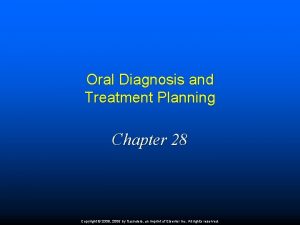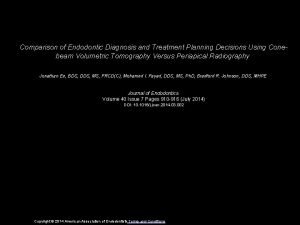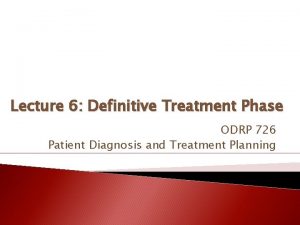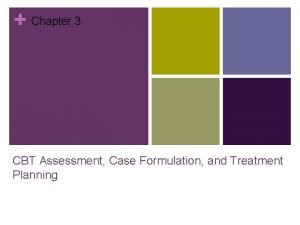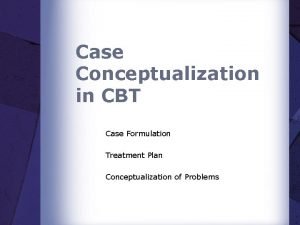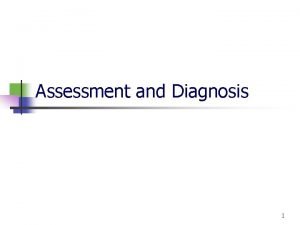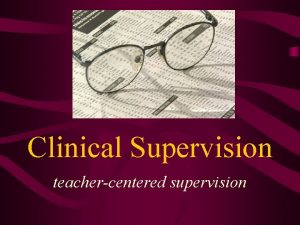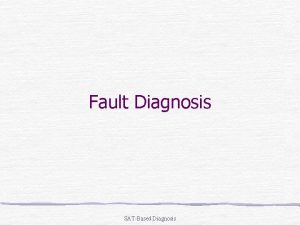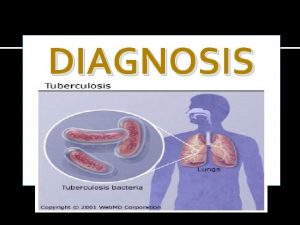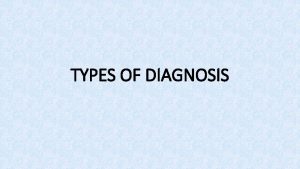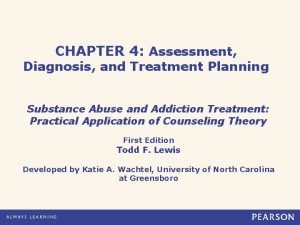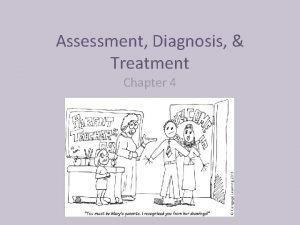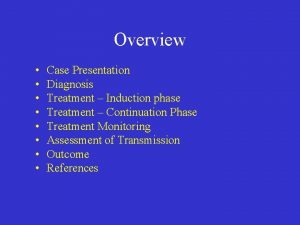Techniques Assessment Diagnosis Treatment Planning Supervision Techniques Assessment





















- Slides: 21

Techniques Assessment Diagnosis Treatment Planning

Supervision Techniques Assessment

Case conceptualization using Concept Maps Reference Liese, B. S. , & Esterline, K. M. (2015). Concept mapping: A supervision strategy for introducing case conceptualization skills to novice therapists. Psychotherapy, 52(2), 190 -194. Concept Map is the active ingredient of a Four-stage Model of Supervision.

Case conceptualization • Defined: “the ability to make some sense of the information that the client is presenting, to identify themes, and to discriminate what is essential information from what is not” (Bernard, 1997, p. 311) • Case conceptualization involves • Collection of client information • Synthesis of client information • Organization of client information • Interpretation of client information • Technique: Use of concept map

Concept map: The active ingredient of a 4 -stage model of Supervision • Concept maps are diagrams that graphically organize relationships between ideas, concepts, or problems • Most helpful to novice therapists although can be utilized by more experienced therapists to identify themes • Concept mapping: Four stage process 1. Generate a problem grid (can be done with or without the client) 2. Use the problem grid to create a concept map 3. Therapist and supervisor meet to review the concept map 4. Therapist discusses the concept map with the client

Advantages • Consistent with the Developmental approach to supervision, concept mapping greatly assists the novice therapist in conceptualizing cases • Allows the Supervisor to see the progress of the Supervisee in the ability to move from surface content to process thinking • Provide more confidence to the supervisor in understanding clearly how cases are being conceptualized based on presenting problems • Are supervisees considering all aspects of the presenting problem

Stage 1: Generate a problem grid • To construct the grid, therapist inquires about the client’s problems and then lists them in the first column with corresponding behaviors, feelings, and thoughts listed in the remaining three columns.

• Process appears mechanical but it is actually a dynamic exchange between the client(s) and therapist • Helps client identify specific problems, associated behaviors, and the difference between emotions and thoughts • Has the potential to strengthen the alliance as they create a shared view of what is going on with the client • Is conversational and not just a list

A conversation not a list: Example

Stage 2: Use the grid to create a concept map

Stage 2: Use the grid to create a concept map • During this phase, therapist generates hypotheses about the client’s functioning and begins the process of case conceptualization • Original conceptualization is transtheoretical • • Example: “Joe tends to create vicious cycles in which he gets depressed and then uses alcohol to relieve depression, resulting in worse depression and marital problems. ” Can then be used to generate specific theoretical approaches to the problem • Example: “Joe’s dysfunctional behaviors are a result of faulty thinking. ” (CBT) • Example: “Joe has an avoidant insecure attachment style, evident by his distancing himself from his wife and isolating himself in times of stress. ” (Psychodynamic/Attachment Theory)

Stage 3: Supervisor Review with Therapist • Provides the opportunity for the Supervisor to assess supervisees ability to move from surface-level processing to deeper-level processing • Supervisor examines the supervisee’s thought process • Helps supervisee develop and strengthen case conceptualization skills • • “How are the client’s problems related to one another? ” Supervisor teaches/facilitates deeper level thinking about presenting problems • Surface level (content) and deeper level (process) Content: Joe’s drinking • Process: Joe’s drinking is a compensatory strategy for emotion regulation •

Stage 4: Therapist returns to discuss with the client • Purpose • Establishes collaborative tone • Demonstrates therapist is working on behalf of the client (thoughtfulness and preparation) • Further expand case conceptualization based on client feedback to the map • Facilitates client’s insight: See linkage and pattern among varying problems • Can provide teaching opportunity between therapist and client (ex: differences between thoughts and emotions and behaviors that subsequently follow)

Supervision Techniques Diagnosis

Diagnosis • Diagnosis is a critical element of the supervisory process • Habitual utilization of the DSM-V • Supervisees may have a tendency to over utilize theory and presenting problems as motivation and focus of change in the client system • Supervisors must draw attention to medication issues and potential contributing medical problems • Unethical to not integrate this into supervision

Diagnosis Training supervisees 1. Training supervisees in the basic use of the DSM 2. Training supervisees in the wise use of the DSM

Diagnosis • • Advantages • Learning the “common language” among mental health professionals • Informs treatment • An atheoretical approach • Third party reimbursement Disadvantages • Focus on pathology limits larger perspective (systems perspective and culture) • Focuses on “negative” aspects of clients’ lives • Provides limited view of clients’ experiences (passing this on to other professionals) • Might limit full case conceptualization • May stifle all factors that contribute to the onset of presenting issues • Focus on individual client

Diagnosis • Consider if and when the presenting symptoms have served the client well at some point in their life • Strengths and resources that have developed out of untreated symptoms • • Technique: Teach the use the “Character Strengths and Virtues” diagnosis (“Manual of the sanities”) • https: //www. authentichappiness. sas. upenn. edu/testcenter Functions the symptoms might be serving • Protectiveness • Connectedness • Problem solving • Cultural connectedness

Diagnosis • Technique/Activity • In Group Supervision, handout case scenario. • Separate Group into sub-groups and have them provide a diagnosis • Bring them back together to compare and contrast diagnosis and approach to reasons they selected that diagnosis • Ask how their own values and life experiences might have led to that diagnosis

Supervision Techniques Treatment Planning

Supervision Techniques Treatment Planning Collaborative Care Map Power Point
 Chapter 28 oral diagnosis and treatment planning
Chapter 28 oral diagnosis and treatment planning Ridge relationship classification
Ridge relationship classification Endodontic diagnosis and treatment planning
Endodontic diagnosis and treatment planning Oral diagnosis and treatment planning ppt
Oral diagnosis and treatment planning ppt Collaborative nursing interventions
Collaborative nursing interventions Medical diagnosis and nursing diagnosis difference
Medical diagnosis and nursing diagnosis difference Medical diagnosis and nursing diagnosis difference
Medical diagnosis and nursing diagnosis difference Nursing process objectives
Nursing process objectives Perbedaan diagnosis gizi dan diagnosis medis
Perbedaan diagnosis gizi dan diagnosis medis Etiotropic phase
Etiotropic phase Advantages and disadvantages of rpd
Advantages and disadvantages of rpd Case formulation cbt example
Case formulation cbt example Rpd treatment planning
Rpd treatment planning Case conceptualization and treatment planning example
Case conceptualization and treatment planning example Assessment for diagnosis
Assessment for diagnosis Assessment and treatment alternatives
Assessment and treatment alternatives Strategic planning vs tactical planning
Strategic planning vs tactical planning Goal achievement matrix
Goal achievement matrix Role segmentation workforce planning
Role segmentation workforce planning N planning
N planning Aggregate planning is capacity planning for
Aggregate planning is capacity planning for Short, medium and long term planning in education
Short, medium and long term planning in education
